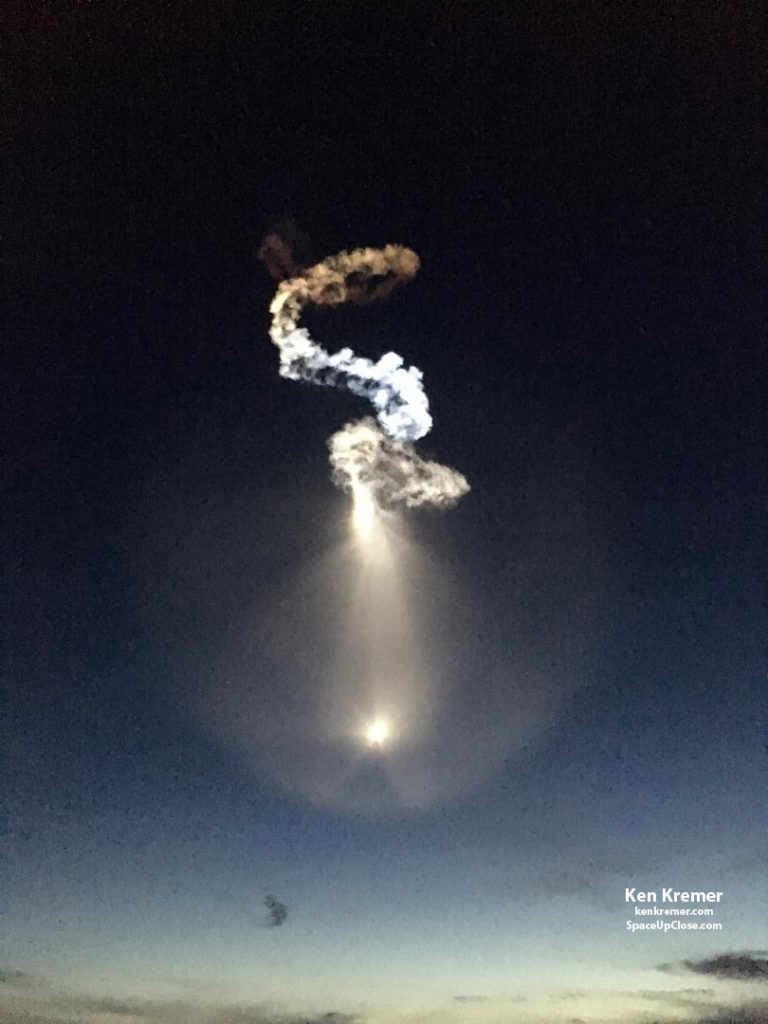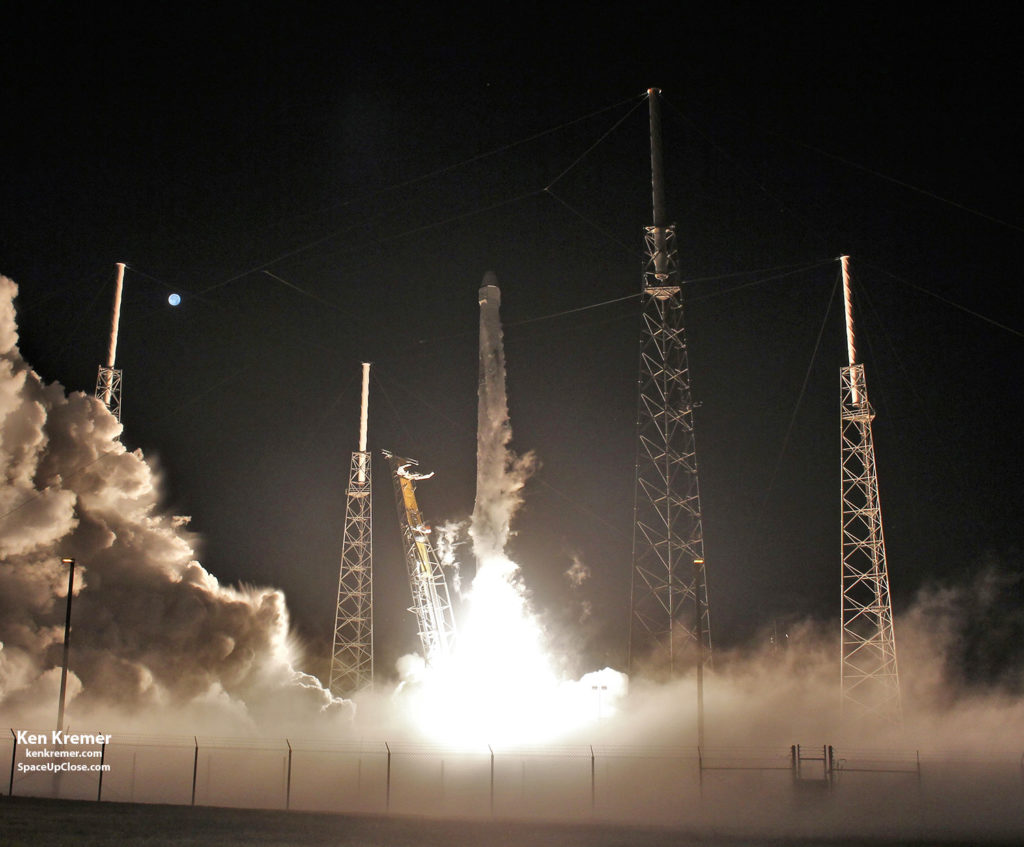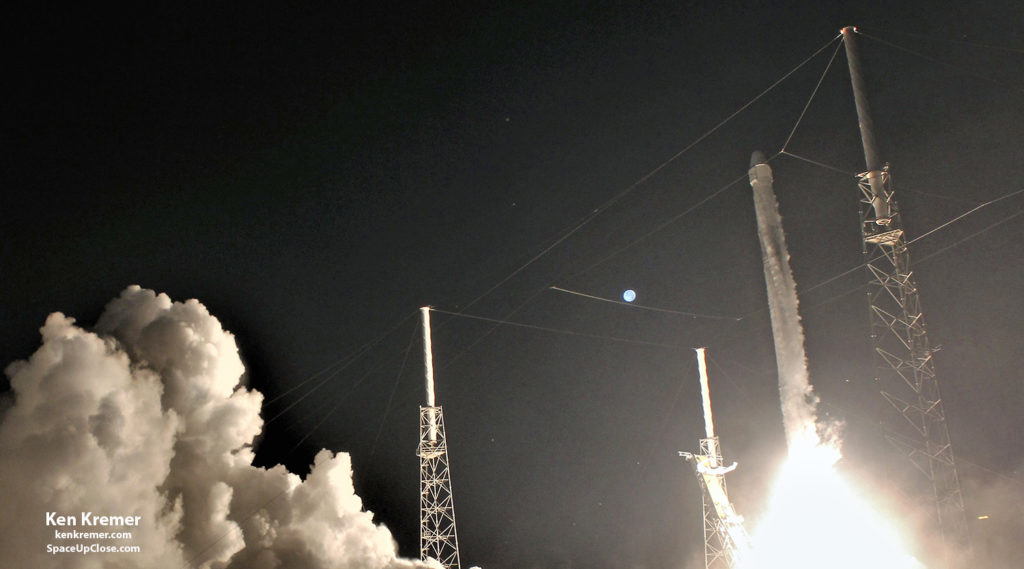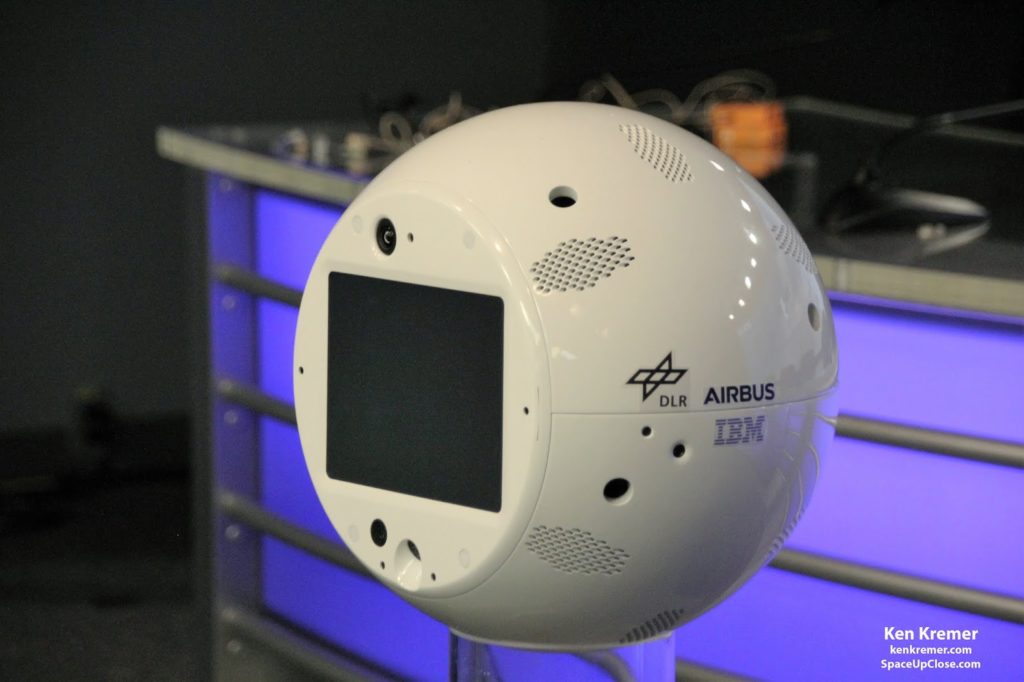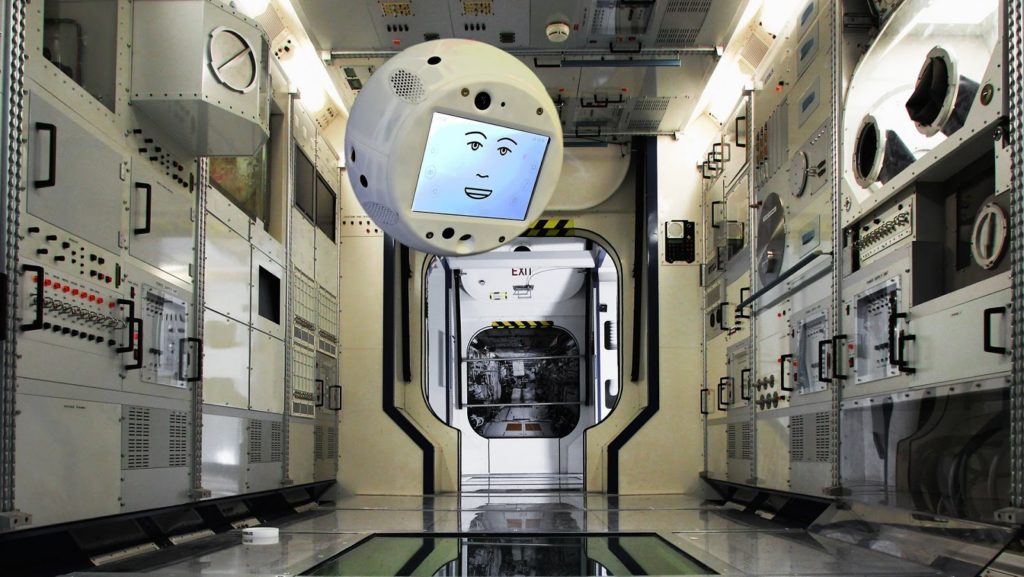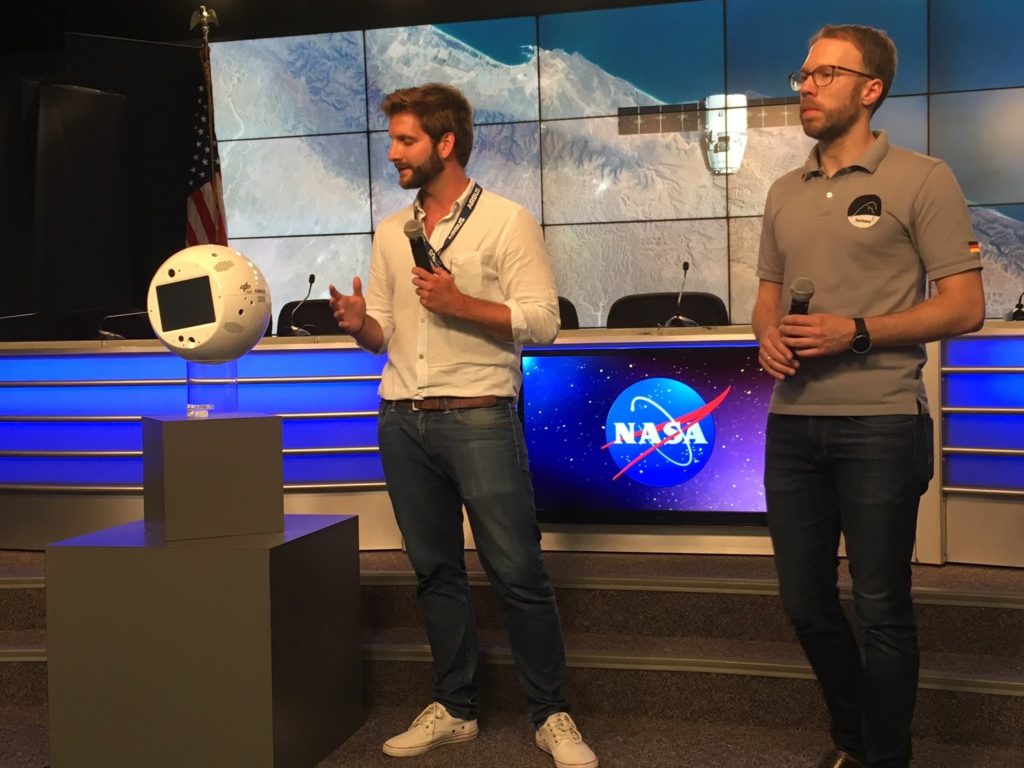SPACE CENTER, FL
– Shortly before dawn Friday a recycled SpaceX
Falcon 9 rocket blasted off from the Florida Space Coast and put on an absolutely
stunning sky show in the first minutes of its critical mission carrying nearly
6000 pounds of research and gear aboard a SpaceX Dragon spacecraft for NASA to
the International Space Station (ISS) – including the AI artificial intelligence
imbued free flying robot named CIMON provided by the German Aerospace Center
(DLR), the ECOSTRESS water monitoring platform from JPL, cancer and human
health research experiments and a new hand for the Canadian built robotic arm.
and developed in record breaking time by DLR and Airbus especially to work with
Germany’s astronaut Alexander Gerst as a mobile astronauts assistant in the
first test of AI hardware on the space station.
Gerst recently arrived at the ISS after launching to space in early June
aboard a Russian Soyuz capsule for his second long term station stay as a flight
engineer for the European Space Agency (ESA).
commercial cargo freighter lifted off into nearly cloudy free pristine twilight
skies precisely on time Friday June 29 at 5:42 a.m. EDT (0942 GMT) from seaside Space Launch Complex-40 (SLC-40)
at Cape Canaveral Air Force Station in Florida.
launched to
the International Space Station under the original Commercial Resupply
Services contract (CRS-1) with NASA.
As the 2 stage
rocket rose to the heavens sunlight glistened on the expanding exhaust plume
creating a giant moving jellyfish-like figure bathed in a mesmerizing and spectacularly
wide range of pastel colors painting the heavens above NASA’s Kennedy Space
Center in Florida as it moved through the skies in the first minutes after liftoff, arcing over on a northeasterly
trajectory as it accelerated skywards delivering the Dragon CRS-15 cargo freighter
to low Earth orbit.
illuminating the exhaust plume from the rocket rising to space in this case creating
a ‘space jellyfish.’
spectacular show in the sky,” Jessica Jensen, director of Dragon mission
management for SpaceX, said at the CRS-15 briefing for reporters at the Kennedy
Space Center.
is, it’s still dark outside, but you have the sun illuminating the plume as
it’s in space. I like to refer to it as the ‘space jellyfish’ that’s coming
down after us.”
including myself felt this was one of the most beautiful and psychedelic
looking launches ever from the Cape.
UpClose gallery of photos herein from myself and space journalist colleagues.
streak shot shows the stunning scene with the growing jellyfish including the first
and second stage firings.
camera photos show the initial moments of the Falcon 9 liftoff backdropped by a nearly full moon, illuminated
98.5% as it soars off pad 40 on its way to the massive million pound orbiting
outpost.
about 213-feet (65-meters) tall.
oxygen/RP-1 fueled Falcon 9 first stage launch launched with 1.7 million pounds
of liftoff thrust powered by nine Merlin 1D engine mounted in an octoweb
arrangement.
second stage separated 2 minutes and 48
seconds after liftoff.
unfurled its solar arrays 11 minutes after liftoff.
and Dragon cargo ship are recycled from earlier missions. The Falcon 9 booster
recently launched NASA’s TESS exoplanet hunter – barely 2 months ago – and the
Dragon flew on the CRS-9 cargo delivery mission, 2 years ago.
loaded with nearly 3 tons of science and supplies for the six person Expedition
56 crew aboard the ISS.
high, 12-foot-diameter Dragon CRS-15 vessel is jam packed with more than 5,900 pounds (about 2,700 kilograms) of science
experiments, research hardware, space parts, food water, clothing and more
supplies for the six person Expedition 56 crew.
artificial intelligence and is known as CIMON, which stands for Crew Interactive Mobile CompanioN.
of a medicine ball sized and functions as a free flying mobile and autonomous
assistance system designed to aid astronauts with their everyday tasks on the
ISS by using Watson AI technology from the
IBM cloud.
Alexander Gerst from Germany will work with CIMON to test its capabilities on
the ISS.
significant in being the first form of Artificial Intelligence (AI) on the space
station. It was developed by prime
contractor Airbus (Friedrichshafen/Bremen, Germany) in cooperation with DLR, the
German Aerospace Center.
technology is about constantly understanding, reasoning and learning, so CIMON
is designed to assist and to create a feeling of talking to a crew mate”, says
DLR.
equipped with a face and voice uses artificial intelligence to becomes a
genuine ‘colleague’ on board, says DLR.
investigations
three day orbital chase and a series of carefully choreographed thruster
firings.
will use the space station’s Canadarm2 robotic arm to capture Dragon when it
arrives at the station. Live coverage of the rendezvous and capture will air on
NASA Television and the agency’s website
beginning at 5:30 a.m. Monday, July 2. Installation coverage is set to begin at
9 a.m.”
pressurized cargo area include a cellular biology investigation (Micro-12)
to understand how microgravity affects the growth, gene expression and ability
of a model bacterium to transfer electrons through its cell membrane along the
bacterial nanowires it produces. Such bacteria could be used in microbial fuel
cells to make electricity from waste organic material.
Spaceborne Thermal Radiometer Experiment on Space Station (ECOSTRESS)
will provide a new space-based measurement of how plants respond to changes in
water availability. This data can help society better manage agricultural water
use.
Interactive MObile companioN (CIMON)
aims to provide first insights into the effects of crew support from an
artificial intelligence (AI) in terms of efficiency and acceptance during
long-term missions in space.
to the space station is a spare Canadian-built Latching End Effector (LEE).
Each end of the Canadarm2 robotic arm has an identical LEE, and they are used
as the “hands” that grapple payloads and visiting cargo spaceships. They also
enable Canadarm2 to “walk” to different locations on the orbiting outpost.
station under NASA’s Commercial Resupply Services contract. Dragon is scheduled
to depart the station in August and return to Earth with more than 3,800 pounds
of research, hardware and crew supplies.
worked continuously aboard the International Space Station, advancing
scientific knowledge and demonstrating new technologies, making research
breakthroughs not possible on Earth that will enable long-duration human and
robotic exploration into deep space. A global endeavor, 230 people from 18
countries have visited the unique microgravity laboratory that has hosted more
than 2,400 research investigations from researchers in 103 countries.
version of the Falcon 9 booster which is being discontinued in favor of the
Block 5. The firm is rapidly switching over to the new Block 5 version first
launched in May.
launch of the Falcon 9. All future ones
will be Block 5 starting in mid July.
easier to turnaround with minimal maintenance, says SpaceX CEO Elon Musk. His
goal is to relaunch a recovered Block 5 a second time within 24 hours by
sometime next year.
on July 2 for a month long stay.
from pad 40.
in 2018 and the 2nd ISS resupply mission for NASA in 2018.
Boeing, Lockheed Martin, Orbital ATK and more space and mission reports direct
from the Kennedy Space Center, Cape Canaveral Air Force Station, Florida and
Wallops Flight Facility, Virginia.
Stay tuned here for Ken’s continuing Earth and Planetary science and human
spaceflight news: www.kenkremer.com
–www.spaceupclose.com – twitter @ken_kremer – email: ken at kenkremer.com
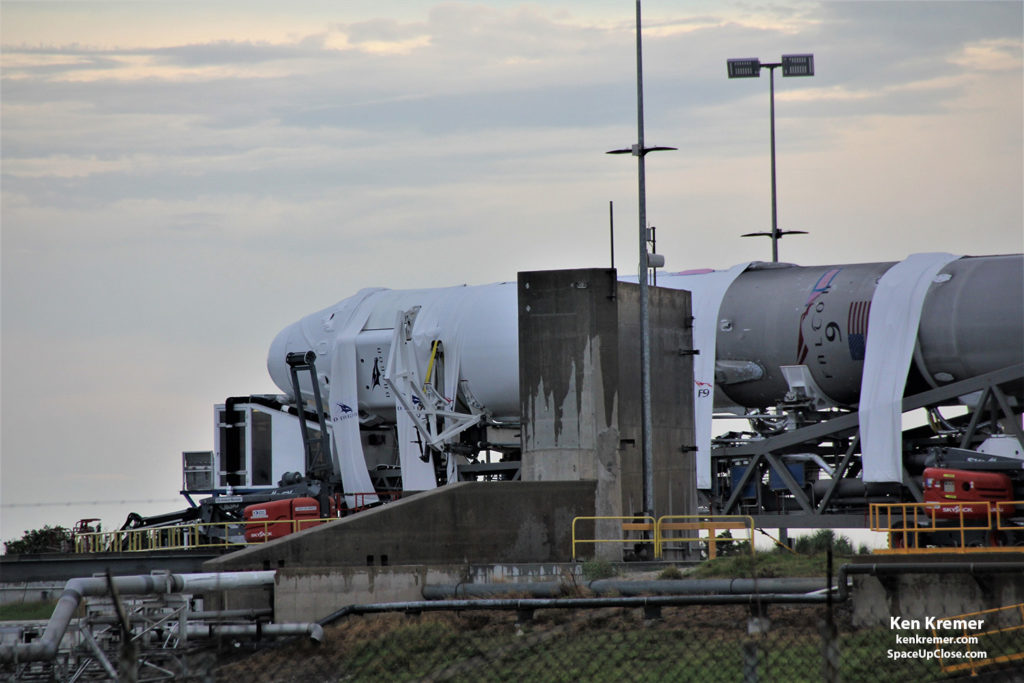 |
|
Under gloomy skies this up close view shows the reused SpaceX
Dragon CRS-15 spacecraft joined to the reused Falcon 9 first stage resting horizontal at Space Launch Complex-40 on June 28 prior to resupply mission to the ISS targeted for launch June 29, 2018 from Cape Canaveral Air Force Station, Florida. Credit: Ken Kremer/kenkremer.com/spaceupclose.com |



